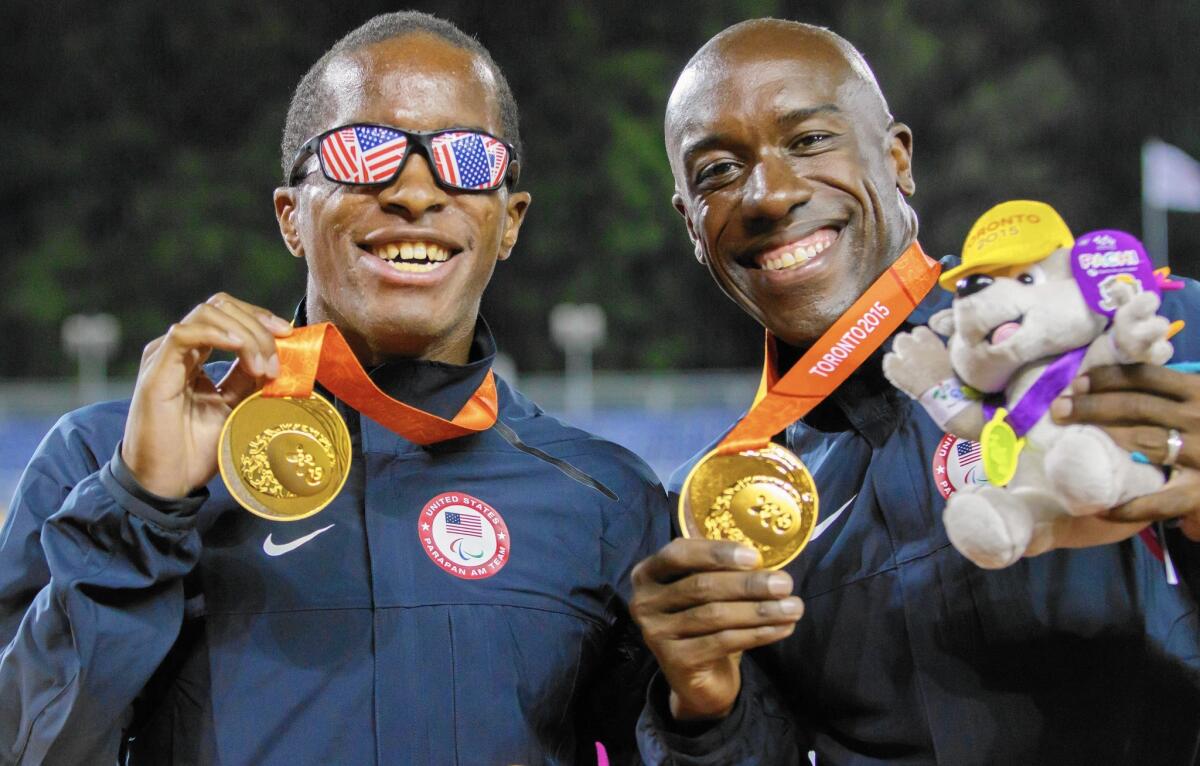Newsletter: Great Reads: In praise of the ellipsis and Verve record covers...
- Share via
Hey there. I'm Kari Howard, and I edit the Great Reads (a.k.a. Column Ones) for the Los Angeles Times.
Two of my biggest loves are narrative journalism and music, and I'm lucky that my days are filled with both: When reading the stories, I get inspired by songs I think fit the article's theme — a soundtrack.
Here are some of the past week's Great Reads, plus their soundtracks.
'The trusting is the hard part'
I love this story about a blind sprinter and his guide. Here are the opening paragraphs, to whet your appetite: The shoelace is worn and frayed, with loops tied at each end. David Brown curls his fingers tightly around one loop, then Jerome Avery grabs the other. "Four inches," David says. "That's all we have between us." The sprinters keep hold of the cord as they burst from the starting blocks, charging side-by-side down the track. "Pick it up," Jerome growls. Their arms pump in unison and their legs churn in identical strides so that, on a hushed autumn morning, they sound like one person running. David moans with exertion. "C'mon," Jerome tells him. "Drive." No blind athlete has ever run 100 meters as fast as David.
David Brown, left, and his guide, Jerome Avery, show off their gold medals during the 2015 Parapan Am Games in Toronto. (Joe Kusumoto Photography)
The soundtrack: "Connected," by the Stereo MCs. I hear this song, and I'm back in 1992, the year I moved to Los Angeles. I can see my stereo (kids, they were wondrous things, a tower of components — turntable, receiver, tape deck, CD player — and a nest of color-coded wires that were a bit terrifying to attach). And I can see the apartment I lived in, just a block from Paramount Studios, the Capitol Records building almost in sight.
Compassion. Disgust. Kindness. Fear. A strip mall and the homeless.
Doug Smith did such a lovely job capturing the nuanced feelings of the merchants in a Sylmar strip mall as increasing numbers of homeless stake a claim on the shopping center. It's not black and white. They're alarmed by the filth and lawlessness of the homeless encroachments, and yet they feel compassion and even a closeness for some of the longtimers. Doug spends time with florist Bonnie Bernard as she makes the rounds of the Gladstone shopping center, where she's had a shop for 23 years. She's trying to gather support for a private security service to oust the homeless, even as she asks all the merchants she meets if they know if one of the longtimers, a hippie with a drinking problem called Richard, is OK. She's convinced that he must have died as he wanted to: alone, with his dog. But everyone tells her he's fine. Finally, she sees him, sitting in his little plot of land. He says he's lived there three years but doesn't consider it permanent. "Next year, I plan on taking off," he says. "I'm going to get me three horses and take them across the United States."
Since security has recently started patrolling the Sylmar shopping center, Cecilia and her husband (not pictured) have moved their belongings to a nearby sidewalk in Sylmar. (Genaro Molina / Los Angeles Times)
The soundtrack: "Keep On Keepin' On," by Nolan Porter. I have to admit, I'd never heard of soul singer Porter until he came onstage with Paul Weller at a recent (amazing) gig at the Fonda. Then I realized that he had done the original version of "If I Could Only Be Sure," a tremendous song that Weller has covered. He should have been big. Or maybe he was, and I just missed out on him. Recommended.
A 13-year-old with bad aim throwing knives near kids on swings
What could go wrong? Carol Williams' story on the rise of patriotic youth groups in Russia is equal parts disturbing and surreal. The opening scene is the aforementioned 13-year-old, doing knife-throwing practice at a playground next to a shabby apartment complex. Inside the building, a group of teens gathers unsupervised in a back room to practice breaking down and reassembling an AK-47. "One minute, 32 seconds — ha! I beat you by one second!" a triumphant Margarita Maluchenkova, an 18-year-old with crimson-tinted hair, proclaims after timing the last of her male club mates with the stopwatch on her smart phone. Thousands of the youth groups have sprung up, answering President Vladimir Putin's call for preparing the next generation of Russian soldiers as the Kremlin flexes its reinvigorated military muscle abroad."
Margarita Maluchenkova, 18, disassembles an AK-74 assault rifle as part of a drill at the Our Army club in Moscow. (Sergei L. Loiko / Los Angeles Times)
The soundtrack: "Hell Is Round the Corner," by Tricky. I love the genealogy of this song. The original riff came from the brilliant Isaac Hayes and his "Ike's Rap II." Then Portishead used it for "Glory Box." (A song that belongs in my top 100.) All three songs are superb.
What I'm reading online
This short piece in the Guardian newspaper about the birth of the ellipsis fascinated me. It apparently first showed up in the 16th century in the English translation of a Roman play. But who did it — the translator or the printer? And what I want to know is: How does someone think of creating a whole new piece of punctuation? And why three dots? Today it seems inconceivable not to have those trailing-off dots as part of our literary arsenal. I'm a big fan. (Now if only I could find out who created the parenthesis, which even a casual reader of my newsletter would know is my favorite piece of punctuation.) The story includes a list of great uses of ellipses. Of course I love the Emily Dickinson poem, but this from a letter by Virginia Woolf to Vita Sackville-West imagining death by a bomb is the best: “Yes. Terrifying. I suppose so — Then a swoon; a drum; two or three gulps attempting consciousness — and then, dot dot dot.”
What's on my bedside table
I'm reading one of my vintage Penguins, "Scenes from a Provincial Life," by William Cooper, and it seems full of ellipses, even if only a few of them are expressly written. Instead, there are a lot of droll scenes where you can just see saucy looks being exchanged, and then the next line is: "At last we were dressed and ready to go." This must have been a risqué book when it first came out in 1950. Even though no actual sex has been described in the part I've read so far, the narrator leaves no doubt that sex is being had — between unmarrieds! Take this exchange: "Now," I said, "you'll have to wait again for your tea." "Ah..." Myrtle gave a heavy, complacent sigh. Her eyes were closed. In due course we had our tea.
What's on my turntable
Although I spend most of my time listening with headphones to Spotify, sometimes I want to hear the needle touching down on vinyl. That's why I have a turntable in my office — and two at home (one inside, and a battery-powered one outside when the weather's fine — which it usually is in Southern California). This week's vinyl: "Trio 64," by Bill Evans. Ah, Verve covers. Almost every one of them a work of art. In this case, literally. I have a pair of albums, the other by Stan Getz and Joao Gilberto, with beautiful abstract paintings by Olga Albizu as the cover art.
Want to chat? Have a great idea for a Great Read? I'm @karihow on Twitter and kari.howard@latimes.com on email.


